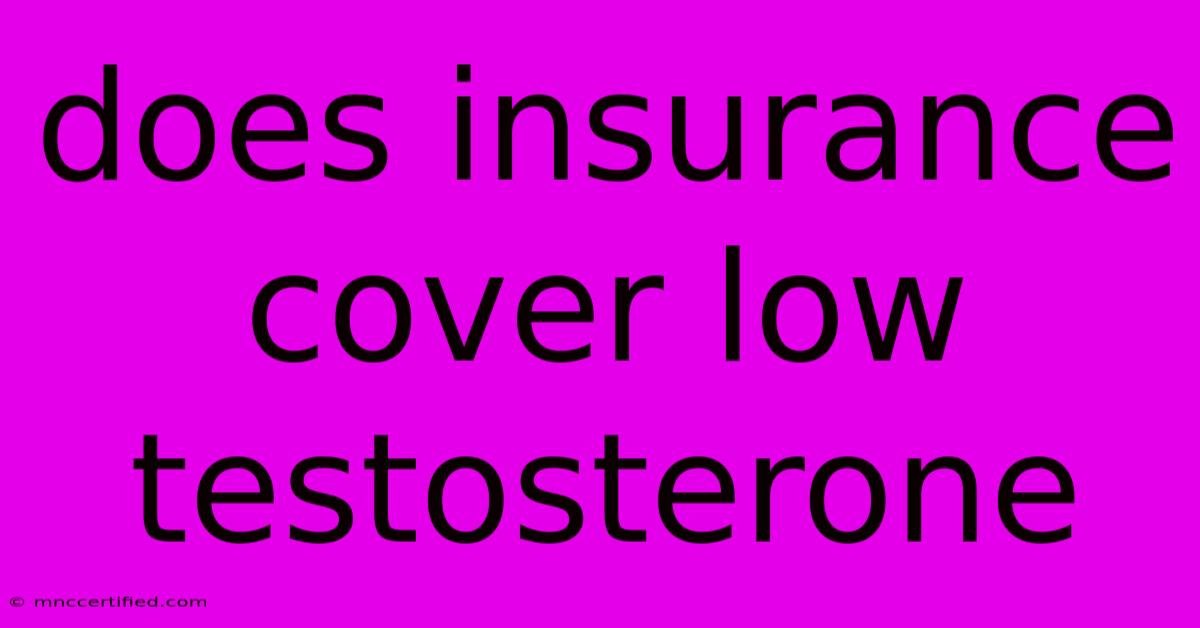Does Insurance Cover Low Testosterone

Table of Contents
Does Insurance Cover Low Testosterone Treatment? A Comprehensive Guide
Low testosterone, also known as hypogonadism, can significantly impact a man's health and well-being. While testosterone replacement therapy (TRT) can be an effective treatment option, many men wonder if their insurance will cover the cost. The answer, unfortunately, isn't straightforward.
Factors Influencing Insurance Coverage
Several factors determine whether your insurance plan will cover TRT:
- Your insurance plan: Each insurance provider has its own set of coverage guidelines. Some plans may cover TRT while others may not, and the level of coverage can vary.
- Your diagnosis: Your insurance company will typically require a clear diagnosis of low testosterone by a qualified medical professional. This diagnosis must be based on specific blood tests and clinical evaluation.
- The type of TRT: The specific form of TRT you need (e.g., injections, gels, patches) might impact coverage.
- Medical necessity: Your doctor must demonstrate that TRT is medically necessary for you, meaning it's not just for enhancing performance or appearance.
- Prior authorization: Many insurance companies require prior authorization for TRT. This process involves your doctor submitting a request to the insurance company for pre-approval of the treatment.
What to Do if Your Insurance Doesn't Cover TRT
If your insurance doesn't cover TRT, don't despair. Here are some options:
- Negotiate with your insurance provider: You can try negotiating with your insurer to cover at least part of the treatment cost.
- Explore alternative treatment options: If TRT isn't covered, your doctor might recommend alternative treatments such as lifestyle changes, supplements, or other medications.
- Seek financial assistance: Some organizations offer financial assistance programs for individuals who need TRT but cannot afford it.
Tips for Improving Your Chances of Coverage
- Choose a qualified doctor: Consult with a doctor who specializes in men's health or hormone replacement therapy. They can accurately diagnose your condition and work with your insurance provider to obtain coverage.
- Gather medical documentation: Ensure you have thorough medical records documenting your low testosterone symptoms and the need for treatment.
- Understand your insurance plan: Familiarize yourself with your insurance plan's coverage details, including formularies and prior authorization requirements.
- Stay informed: Keep up-to-date on insurance policies and any changes that may affect your coverage.
The Bottom Line
While insurance coverage for TRT can be challenging to navigate, it's crucial to understand your plan's specifics and work closely with your doctor. By following these tips and staying informed, you can increase your chances of getting the treatment you need without breaking the bank.
Remember, this information is for educational purposes only and should not be considered medical advice. Always consult with a qualified healthcare professional before making any decisions about your health or treatment.
Keywords: low testosterone, hypogonadism, testosterone replacement therapy, TRT, insurance coverage, medical necessity, prior authorization, treatment options, financial assistance, doctor, diagnosis, insurance plan, coverage details.

Thank you for visiting our website wich cover about Does Insurance Cover Low Testosterone. We hope the information provided has been useful to you. Feel free to contact us if you have any questions or need further assistance. See you next time and dont miss to bookmark.
Featured Posts
-
Bailey Point Investment Group Website
Nov 10, 2024
-
U 19 T20 World Cup Nepal Wins Again
Nov 10, 2024
-
Texas Tech Vs Colorado Injury News
Nov 10, 2024
-
Hugh Has The Choice Between Investing
Nov 10, 2024
-
Life Insurance Awareness Month Quotes
Nov 10, 2024